Peter Dornauf – 3 September, 2010
Shows like these always seem to attract their share of stuff from the gimmicky end of the spectrum produced by artists desperately striving to be terribly avant-garde but ending up only looking ephemeral and slightly silly, but when large amounts of money is involved and judges collude in this, who can blame the practitioners. It's a game everyone has learnt how to play.
Hamilton
Bold Horizon National Contemporary Art Award 2010
Judge: Rachel Kent
7 August - 9 January 2011
Whenever I walk out of one of these art awards feeling somewhat deflated, my immediate reaction is to want to see the works that didn’t make the cut. I want a Salon des Refuses and take in all the Manets that were deemed below par, insufficiently worthy of inclusion in the show.
My second reaction, after reading the artists’ statements that accompany their work, is to suggest a separate award on the basis of the most pretentious piece of inflated rhetoric associated with the least deserving creation. Often there seems to be a direct correlation, a kind of law of diminishing returns operating here; the more overblown the text, the less significant the piece.
My favourite from the show in this category would have to include such gems as “super-personal stylistic wanderings” and “problematisation”. One got the feeling with certain works that it wasn’t about the art so much as the writing about the art that recommended it.
And speaking of ironies, the work that did it least for this reviewer was the winner. Maybe it was the artist’s statement that impressed the judge. It waxed on about matters political and global and the works themselves certainly were happily in the shapes of globes. Christchurch-born, Locust Jones’s, Lozenge of Dawn, had enough in the title alone to have one reaching for a container, but this papier-mache ball creation was certainly too much for some, like Mark Curtis (Hamilton artist) who called it a “nasty craft project”. I have to admit it did remind me of stuff seen sitting at the discarded end of prep-school classrooms. Still, the judge, Rachel Kent, (Senior Curator, Museum of Contemporary Art, Sydney) enjoyed its “playfulness and tactility”.
What was pleasing in the show was to see the inclusion of several sculptural works. Heap, by Ruth Thomas-Edmond, made of recycled cardboard, was a particularly inventive and standout piece.
Photography had a strong showing in The New Anatomy Lesson by Heather Straka while Blind Faith, a wall hanging by Megan Hansen-Knarhoi was a clever satirical take on the subject of religion. In terms of painting, Helen Calder’s bright globular and viscous hangings were able to catch the eye. Any of these would have been worthy winners.
Paintings don’t usually figure too prominently in art award selection these days, eg. The Walters (token presence, Saskia Leek) despite all the postmodern preaching on pluralism. Conceptual tends to predominate and there were several boring examples in this selection.
Shows like these always seem to attract their share of stuff from the gimmicky end of the spectrum produced by artists desperately striving to be terribly avant-garde but ending up only looking ephemeral and slightly silly, but when large amounts of money is involved and judges collude in this, who can blame the practitioners. It’s a game everyone has learnt how to play.
Having said that, there were some in the show where their innovation matched their acumen. One such was Fluoro Koeaea, by Gina Matchitt where duct tape was used in a mimicked construction of Maori motifs; a deserving jaunty entrant that helped make this show worthy of a prolonged visit.
Peter Dornauf
Recent Comments
Roger Boyce
Mr. Dornauf queries (rhetorically I assume) Q. "When are we going to stop doing this?" I just adore answering rhetorical ...
Peter Dornauf
Judges and professionalism. To think that any judge on any matter can be completely objective is to display a naivety ...
Roger Boyce
Mr. Dornauf pretends to sleuth from my earlier posted comments, which were: I imagine the curator has seen (and likely ...
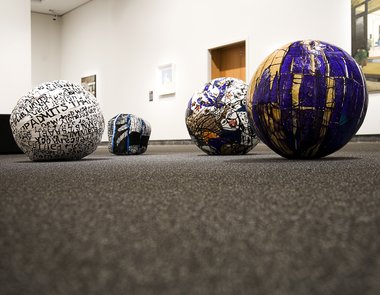

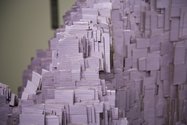


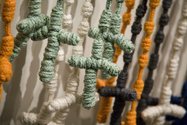
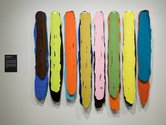
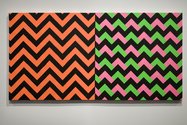
 Two Rooms presents a program of residencies and projects
Two Rooms presents a program of residencies and projects Advertising in this column
Advertising in this column



This Discussion has 13 comments.
Comment
Simon Esling, 9:49 a.m. 3 September, 2010 #
Re: the winner. One reassuring aspect might be a lack of nepotism. She liked it, so she gave the award. Lucky Locust. I agree completely with what you have said though. I felt Ruth would have been a worthy winner.
victor berezovsky, 7:34 p.m. 5 September, 2010 #
Simon Esling, Ruth shows in your gallery. Why mention your preference given this connection. Particularly as you suggest a lack of nepotism as a positive outcome of the selection and then take a swipe at the awarded artist. Congratulations to the winner.
John Hurrell, 9:42 p.m. 5 September, 2010 #
Victor, showing in the same gallery doesn't necessarily mean artists get on or have the same sensibility. They might though. Especially in Auckland where artists do seem to be terribly tribal.
You think perhaps that there is a 'pack mentality' here where artists showing in the same gallery all stick together?
victor berezovsky, 11:28 p.m. 5 September, 2010 #
I wasn't discussing the particulars of any art scene or gallery. I won't be drawn into such a tiring and futile exchange. Rather I think Simon Esling’s comment was casual and rather dismissive. Dismissive of the judges selection and the artist. What exactly does he agree with? Why Ruth Thomas-Edmonds work over the other selections. I’m sure he appreciates comments leveled at his work to be articulated.
Clem Devine, 10:25 a.m. 6 September, 2010 #
Victor, isn't Simon allowed to comment on which work he prefers in this exhibition? I didn't know this wasn't allowed? Maybe it isn't surprising that artists who exhibit in particular galleries like their fellow stables work? Normally the owner curates a sensibility of art which appeals to their market.
Personally I think Jones work is derivative, but the institutional system appear to be stuck in a post 1970's conceptual period. Curators and artists are very keen on recycling and representing old ideas. I've been reading a number of international publications recently and it's all the same. To think of it though, our own art market is somewhat detached from this ephemeral practice. The only medium thats really happening is photography in my opinion.
Simon Esling, 2:20 p.m. 6 September, 2010 #
Hi Victor,
I guess it was a bit brief on my part. I think the selection coming from someone off-shore makes it more exciting, more random. I think the selection of Locust Jones is refreshing. I just don't like the work that won it for him. But that isn't to say Jones doesn't make good work. Of the finalists I saw I felt Ruth's was more sophisticated (again, just my opinion and obviously not one shared by the judge). Also, I don't mean to dismiss the judges choice, she has given her reasons, but I wasn't that enthralled with it and found Peter's review witty and incisive and I was actually agreeing with him more than anything. Again, these are subjective opinions. As for a nepotism of thought(?) due to exhibiting at the same gallery...Well, you will be dismayed to know that one of my other favourites was Graham Fletcher. I really can't say more to defend my opinions except to add that I have some broad experience and knowledge of contemporary art and would make a fine judge. Ha!
Roger Boyce, 9:24 p.m. 7 September, 2010 #
I don't know if it's rolling Canterbury aftershocks, Dornauf's scrupulously sans-analysis 'opinion' piece, or the - for the most part - non-substantive island artworld sniping in the related EC discussion that's making me bilious at the mo'.
I know I'll pay for this remark - as an expat & auslander I'd like to note the tendency of Aotearoan artworld partisans to take literally de Quincy's satirical and fictional essay - "On Murder Considered as one of the Fine Arts".
Mind you, I do like a little demimonde mayhem now and again but I relish anatomy with my murder....rather than overhearing soccer-yobbish assailants simply shouting their team affiliations while knifing opponents. I know, I know I'm exaggerating...I said I was a mite queasy.
Full disclosure - I wrote a recent Art in America review covering Locust Jone's show at MOP, Sydney. I had no idea, as I was deciding to write about his show, that he was (by origin) a Kiwi. I might have thought twice about getting anywhere near archipelago crossfire.
Jone's show at MOP was able to overcome its tendency toward over-earnestness (to the point of bathos) by carrying a full (and equal) measure of barely repressed anger-as-tocsin. There was an urgency of technique and hurried reliance on provisional (badly crafted) means which spoke less to the latest stylish slouchiness and more to a by-any- means-that-came-to-hand sort of approach to getting the work done. The installation I saw worked by getting it exactly wrong.
Having said that I need also state that I loathe group shows for what they do to individual works of art. They do the same thing for works of art that open casting calls do for journeyman actors. That is rob auditioners of any chance of dignity or craft, in return for an outside shot at a payday.
I imagine the curator has seen (and likely remembered) Jones' work in Australia (her country of origin) where his practice has begun to be seen and recognized more in the last few years. That possible fact would have played in his favor. Which will give the mob another reason for resentment.
In person I'd probably enjoy arguing pros and cons with the reviewer and his discussion interlocuteurs ... but I'd insist (as I wiped blood off my own knife)that if I (or the artists in question) were to be dissected that it be done with some naming of the mortal parts being dismembered.
John Hurrell, 1:48 a.m. 8 September, 2010 #
Here is the link to Roger Boyce's Art In America article on Locust Jones' show in Sydney:
http://www.artinamericamagazine.com/reviews/locut-jones/
Peter Dornauf, 2:02 p.m. 8 September, 2010 #
If Roger Boyce wants the parts named, then here’s one. I personally thought the Jones work lacked presence. It appeared trivial in its context for what it was claiming. I don’t mind the crude and handmade look, in fact I’m partial to a bit of rough, but the piece or pieces didn’t stand up. In fact one of the balls literally looked as if it was sat on in transit. Maybe it was a metaphor, but the medium didn’t match up with the message.
The other issue concerns his revelation that Jones is a long time resident of Australia. As an Australian judge picked him it starts to smell just a tad, given that any or many of the works by others in the show would have been equally worthy recipients. Everyone knows that these sorts of competitions are lotteries but not all know that the dice is sometimes loaded.
John Hurrell, 10:51 p.m. 8 September, 2010 #
If I can throw some ideas in here, we all know competition judges are likely to have contextual information about the entrants that most members of the visiting public lack. After all, that is why they are picked to adjudicate - they are knowledgeable. The problem is that if an Australian judge only knows about about the context of Australian art, and not New Zealand, then there is no benefit in inviting them.
I personally don't think this is likely to be the case. Actually it is more likely Rachel Kent is also knowledgeable about New Zealand art and came to a fair and considered decision. I do know she has been visiting this country's galleries of and on for at least fifteen years (because I met her in the nineties). Her choice would not have been made lightly.
Now my own taste in art could never support her choice (I'm saying that whilst never actually visiting the show.I've never seen the winning work) but that is not the point. She has the knowledge and experience not to act rashly.
Roger Boyce, 11:17 p.m. 8 September, 2010 #
Mr. Dornauf pretends to sleuth from my earlier posted comments, which were: I imagine the curator has seen (and likely remembered) Jones' work in Australia (her country of origin) where his practice has begun to be seen and recognized more in the last few years. That possible fact would have played in his favor. Which will give the mob another reason for resentment -
And then Detective Peter D. states...sotto voce:
" - Jones is a long time resident of Australia. As an Australian judge picked him it starts to smell just a tad,"
Yes, Mr. D., but where's the McGuffin?
To state, flat-footedly, as does Dornauf, that 'it smells' (Australian based judge & Australian based artist, omigod) more than implies that the judge acted from a footing of art-nationalism or, better yet, knows Jones personally, rather than, say, his professional work....which is enough of a cerebral stretch to put the thinking well within the xenophobic paranoia-in-the-service-of-professional-resentment category.
I can only assume such provocative ('it stinks') comments would not be forthcoming, from this artist-novelist-reviewer of the Waikato, if a New Zealand judge/curator had (more fairly of course) picked a New Zealand based artist...although, in my limited experience, New Zealand is exceeded in incestuous art-world provincialism only by Manhattan.
As for what an artist claims (in written text as opposed to the apparent claims of the visual work itself) for their practice - frankly, I think it matters not one whit.
In other words I don't give a..... And I don't read that crap.
Unfortunately today's young artists have been paper-trained to write the way they do by public art funding masters. Artists are, as always, accommodating, when it comes to folding-money. And well, they should/must be.
While I appreciate an artist who can think, talk and write while standing on his/her hind legs...the history of art is chock full of artists who bloviate (Barney Newman being the quintessential sinner in that perennial category) yet manage to turn out some rather viewable goods.
I'd guess, and concur that Jones' Waikato-submitted work - as further states Dornauf - "-lacked presence." in the Waikato group show mash-up.
In my first post I note the generally deleterious effect of group shows on artworks. Further supporting my surmise that the Australian judge may have had the chance to see a better presentation of Jones'.... work as would a New Zealand judge likely have the chance to see a better presentation of a New Zealand artists work and thus - in that hypothetical case - give the New Zealand artists an equally unfair (but hardly conspiratorial) advantage.
Welcome one and all to the little village called visual art. The next contest will begin in just a moment.
Peter Dornauf, 3:11 p.m. 9 September, 2010 #
Judges and professionalism. To think that any judge on any matter can be completely objective is to display a naivety that is both astonishing and charming. Basic psychology tells us otherwise. And to think the contrary suggests a certain hubris too about the human species. How many times have we all seen this? I have no doubt that the Australian judge is totally professional (and also totally human) but when it all comes down to it, any number in the show could have been winners. It’s a silly game really. It’s like saying apples are better than bananas, or Miss New Zealand not as good as Miss Australia. When are we going to stop doing this?
Roger Boyce, 5:16 p.m. 9 September, 2010 #
Mr. Dornauf queries (rhetorically I assume)
Q. "When are we going to stop doing this?"
I just adore answering rhetorical questions.
A. When we evolve in to strictly-cerebral-exterior-brained beings with tiny weakened bodies and no bum.
In other words, as long as artists-on-the-make need to eat and civil society craves cultural divertissement there will be contests. Be they sublimated rivalries between the sauntering boulevardiers of K Road or immodestly sprinting art-marathon mobs jammed shoulder to shoulder at the starting line of provincial mausoleums-to- middle class-virtue....such as this years award engagement in Hamilton.
I sincerely thank you Mr. Dornauf for not rising impetuously to the large and poorly tied fly I dropped onto your pool. You're a wily old trout.
Participate
Register to Participate.
Sign in
Sign in to an existing account.